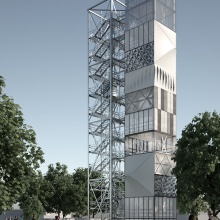Lightweight constructions require fewer materials, which is one way of saving raw materials. At the same time these supporting structures must also be able to withstand the resulting loads. However, the loads that occur are not known in advance, so very conservative estimates are made, which means that such structures are oversized. Researchers at the University of Stuttgart have actively developed adaptive structural elements that can be used to manipulate the load transfer behavior in a structure. This innovation makes it possible to build forward-looking ultra-light constructions, which use significantly less building materials in comparison to classic lightweight constructions, without compromising the safety of the supporting structure. To enable this, actuators – active elements – are integrated into the passive supporting structure, either in parallel or in series.
The actuator components, developed by Julia Wagner and Dr. Michael Böhm at the Institute for System Dynamics (ISYS), together with Timon Burghardt from the Institute for Engineering Design and Industrial Design (IKTD), comprise the active elements and mechanical components for force transmission. In its passive state, the latter serve to maintain the initial load, thus eliminating the need for additional elements to serve this purpose.
Drastic reduction of materials and weight
Such building components complement a conventional lightweight structure to create an ultra-lightweight structure capable of actively compensating deformations caused by dynamic and static loads. Every element exerts or dissipates tensile or compressive forces, depending on the load case. This is done automatically by combining appropriate sensors and a control unit. For example, the active elements can be operated hydraulically, pneumatically or (piezo-)electrically. With these adaptive supporting elements, it is possible to significantly reduce the amount of materials used, and, therefore, the total weight of the completed construction. At the same time, the damping of all vibrations also significantly increases the service life of the load-bearing structures, which also greatly reduces the amount of waste and thus the amount of waste disposal. These actuators could conceivably be used for all high-rise buildings, not just lightweight structures. They could also be used in existing structures, such as bridges.
Patent applications have been submitted for these structural elements. The University of Stuttgart has commissioned the Technology Licensing Office (TLB) GmbH with the commercial implementation of the invention and is looking for partners from industry for the market launch.
The high-rise is located on Campus Vaihingen
The adaptive structural elements are currently being researched in a practical context in a demonstration building. This approximately 37-meter-high adaptive high-rise building is located on the campus of the University of Stuttgart and was built as part of Collaborative Research Center 1244, which is funded by the German Research Foundation and led by Prof. Werner Sobek ((Institute for Lightweight Design and Construction ILEK) and Prof. Oliver Sawodny (Institute for System Dynamics ISYS).
The SFB 1244 at the University of Stuttgart focuses on the question of how, in view of a growing world population and shrinking resources, more living space can be created using less material in the future. With the aim of maximizing savings in material and energy consumption, while increasing user comfort, 14 university institutes from a wide range of disciplines are researching the potential and applicability of adaptive building envelopes and structures in construction. The research includes both the development of individual (building) components and their integration into an overall system.
| Contact | Annette Siller, Technology Licensing Office (TLB) GmbH, E-Mail: asiller@tlb.de |
|---|


